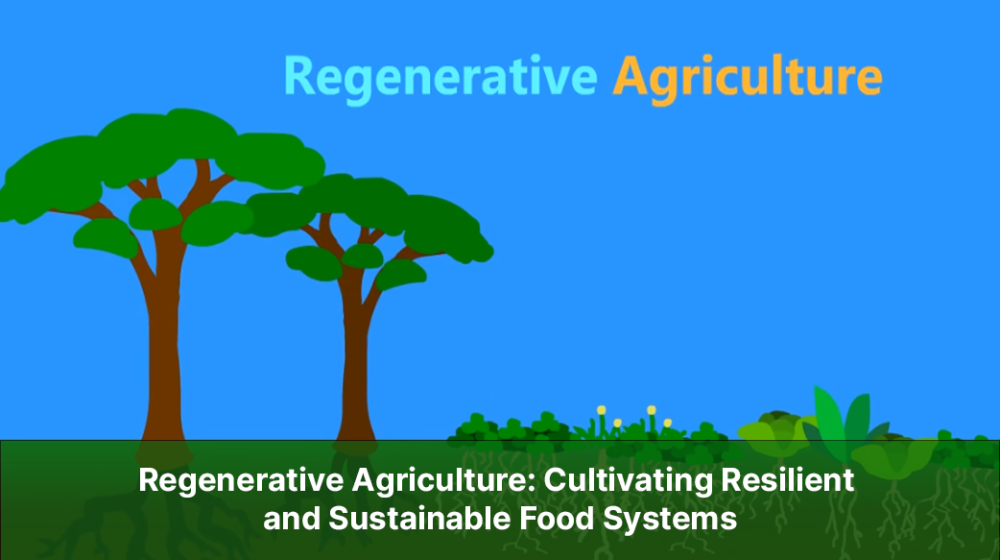Regenerative Agriculture: Cultivating Resilient and Sustainable Food Systems
In the face of environmental challenges and the urgent need for sustainable food production, regenerative agriculture has emerged as a transformative approach. Regenerative agriculture goes beyond conventional farming practices by focusing on soil health, biodiversity, and ecosystem restoration. This article explores the principles of regenerative agriculture and highlights its implementation in countries like Pakistan, the USA, Canada, Australia, and the UK.
Understanding Regenerative Agriculture: Regenerative agriculture is a holistic approach that aims to restore and enhance the health of ecosystems, improve soil quality, and promote biodiversity. It emphasizes the integration of traditional knowledge, innovative techniques, and sustainable practices to create resilient and productive food systems. By adopting regenerative agriculture, farmers can mitigate the effects of climate change, reduce environmental impact, and ensure long-term food security.
Key Principles of Regenerative Agriculture:
- Soil Health: Regenerative agriculture recognizes the importance of healthy soils as the foundation of sustainable farming. Practices such as cover cropping, crop rotation, and minimal tillage help increase soil organic matter, improve water retention, and enhance nutrient cycling.
- Biodiversity Conservation: Encouraging biodiversity on farmland is crucial for ecosystem balance and resilience. Planting hedgerows, preserving natural habitats, and incorporating diverse crop varieties attract beneficial insects, pollinators, and soil microorganisms, promoting natural pest control and enhancing overall ecosystem health.
- Water Management: Efficient water management is central to regenerative agriculture. Strategies such as contour farming, terracing, and precision irrigation minimize water runoff, increase water-use efficiency, and prevent soil erosion.
- Carbon Sequestration: Regenerative agriculture actively sequesters carbon from the atmosphere and stores it in the soil. Practices like agroforestry, rotational grazing, and cover cropping enhance carbon capture, mitigating climate change and improving soil fertility.
Regenerative Agriculture Around the World:
- Pakistan: In Pakistan, regenerative agriculture practices are gaining traction as a means to combat desertification, soil degradation, and water scarcity. Initiatives such as the Sustainable Development Policy Institute’s (SDPI) Sustainable Agriculture Programme promote regenerative techniques like agroforestry, water conservation, and organic farming. By embracing regenerative agriculture, Pakistani farmers can restore soil health, increase productivity, and adapt to a changing climate.
- USA: Regenerative agriculture has gained momentum in the United States, with farmers recognizing its potential to revitalize degraded farmland and improve ecological resilience. Organizations like the Rodale Institute advocate for regenerative practices such as organic farming, cover cropping, and rotational grazing. These methods rebuild soil fertility, enhance nutrient density in crops, and reduce reliance on synthetic inputs.
- Canada: Canada is witnessing a surge in regenerative agriculture practices as farmers seek alternatives to conventional farming systems. The Maple Bloom Farm in British Columbia exemplifies regenerative agriculture through permaculture techniques, agroforestry, and holistic management practices. By incorporating regenerative principles, Canadian farmers can restore soil health, preserve water resources, and foster sustainable rural communities.
- Australia: With its vast agricultural landscapes and exposure to climate extremes, Australia has embraced regenerative agriculture as a means to combat land degradation and increase resilience. The Mulloon Institute’s Regenerative Landscape Plan in New South Wales showcases the benefits of regenerative farming, including improved soil structure, increased water infiltration, and enhanced biodiversity. Australian farmers are increasingly adopting regenerative practices to mitigate drought impacts, conserve water, and restore degraded ecosystems.
- UK: The United Kingdom is at the forefront of regenerative agriculture, with initiatives like the Farm Carbon Cutting Toolkit promoting regenerative practices among farmers. Implementations include regenerative grazing systems, agroforestry, and organic agriculture. By restoring soil health and promoting biodiversity, UK farmers are enhancing food quality, reducing environmental impact, and building climate resilience.
Regenerative agriculture holds immense potential for transforming our agricultural systems into sustainable, resilient, and regenerative models. Its principles, including soil health, biodiversity conservation, water management, and carbon sequestration, offer practical solutions to address environmental challenges worldwide. By adopting regenerative agriculture practices, countries like Pakistan, the USA, Canada, Australia, and the UK can pave the way for a more sustainable and food-secure future while healing the planet.
